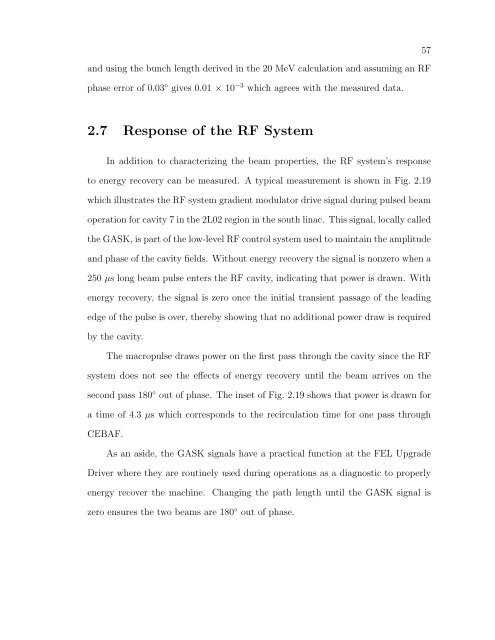STUDIES OF ENERGY RECOVERY LINACS AT ... - CASA
STUDIES OF ENERGY RECOVERY LINACS AT ... - CASA
STUDIES OF ENERGY RECOVERY LINACS AT ... - CASA
You also want an ePaper? Increase the reach of your titles
YUMPU automatically turns print PDFs into web optimized ePapers that Google loves.
and using the bunch length derived in the 20 MeV calculation and assuming an RF<br />
phase error of 0.03 ◦ gives 0.01 × 10 −3 which agrees with the measured data.<br />
2.7 Response of the RF System<br />
In addition to characterizing the beam properties, the RF system’s response<br />
to energy recovery can be measured. A typical measurement is shown in Fig. 2.19<br />
which illustrates the RF system gradient modulator drive signal during pulsed beam<br />
operation for cavity 7 in the 2L02 region in the south linac. This signal, locally called<br />
the GASK, is part of the low-level RF control system used to maintain the amplitude<br />
and phase of the cavity fields. Without energy recovery the signal is nonzero when a<br />
250 µs long beam pulse enters the RF cavity, indicating that power is drawn. With<br />
energy recovery, the signal is zero once the initial transient passage of the leading<br />
edge of the pulse is over, thereby showing that no additional power draw is required<br />
by the cavity.<br />
The macropulse draws power on the first pass through the cavity since the RF<br />
system does not see the effects of energy recovery until the beam arrives on the<br />
second pass 180 ◦ out of phase. The inset of Fig. 2.19 shows that power is drawn for<br />
a time of 4.3 µs which corresponds to the recirculation time for one pass through<br />
CEBAF.<br />
As an aside, the GASK signals have a practical function at the FEL Upgrade<br />
Driver where they are routinely used during operations as a diagnostic to properly<br />
energy recover the machine. Changing the path length until the GASK signal is<br />
zero ensures the two beams are 180 ◦ out of phase.<br />
57
















